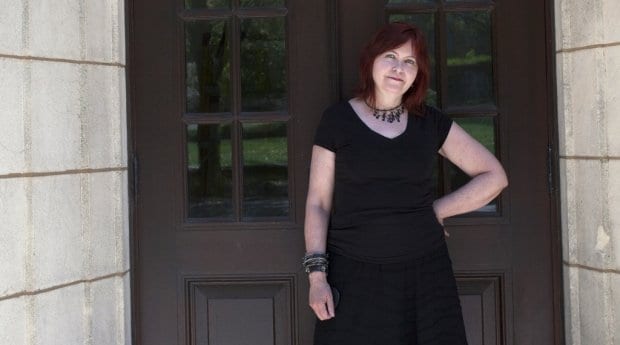Canadian LGBT history was made in the early morning hours of Sunday, July 15, 1990, when Montreal police raided the Sex Garage queer loft party in Old Montreal, in what is now widely regarded as Montreal’s Stonewall.
At the invitation of party organizer Nicolas Jenkins, Montreal photojournalist Linda Dawn Hammond, now based in Toronto, photographed the Sex Garage loft party and showdown with police, and attended the violent protest outside Montreal Police Station 25 on July 16, 1990, where police beat protesters in full view of the media.
The raid and subsequent protest marked a turning point in the struggle for LGBT civil rights in Quebec. But, Jenkins says, “If it wasn’t for Linda Dawn Hammond’s photos of my party and the police raid, there would be no photographic evidence of police violence that night. It would have been our word against theirs.”
Hammond’s photos of Sex Garage will be exhibited at a free outdoor Sex Garage 25th anniversary exhibition at Place Emilie-Gamelin (Berri Square) that will run Aug 12–16, 2015, during Fierté Montreal Pride.
Daily Xtra: Did you know at the time that you were witnessing history?
Linda Dawn Hammond: Not history, but I knew immediately how important it was to get these images to prove what was happening. Even before the police removed their identification badges in front of us, we all knew before exiting the warehouse that one man at the party, Bruce Buck, had been taken by police between parked cars — where they thought there were no witnesses — and was badly beaten. Friends of mine in another loft were horrified to see this from a window. I’ve read later media accounts and I remember the timing of things differently. For example, the men who bared their asses to the approximately 32 cops did this after the Buck beating, not before, as I witnessed that. They did it in response to homophobic taunts by the cops and in the knowledge that violence had already occurred.
Today people with cellphones and cameras could easily document all of this, but in 1990 this was not the case. I was one of the only people present with a camera. I saw what was underway as a human rights violation and was determined to document it. I photographed the police before and after they removed their identification badges, which they did as a direct provocation before they started running us up Rue De La Gauchetière and Beaver Hall Hill, beating us with their billy clubs. In total I shot three rolls of film.
DX: Were you afraid of being beat up by the police the night of the Sex Garage raid?
LDH: I knew I was going to be a police target because I had a camera with a flash. My batteries were low because I was shooting all night at the party. So I would take a photo, retreat, wait for the batteries to come back to full power, then I’d dart in again. Outside I shot maybe 50 photos. Every time I took a photo my flash would pop, so the police always knew where I was. I was surprised they hadn’t tackled me yet, but I figured they would get to me later. I was also aware of the possibility that the police could use my photos for their own use.
DX: How did the police attack you?
LDH: A cop knocked my knees out from behind, then hit me across the chest area where I was holding the camera. When I fell I twisted to protect the camera. When it hit the pavement, it dislodged the flash, which went in one direction while I slid my camera up the hill. Another (partygoer) grabbed my camera while police jumped for the flash, thinking it was my camera. That gave me the opportunity to run. No one wanted my camera, it was a hot potato. I ran directly to the person with my camera and took it.
DX: After retrieving your camera and film, you brought your film directly to La Presse daily newspaper.
LDH: A friend and I waited while they processed the film. Then after we were done, we went over to The Montreal Gazette, because we wanted coverage in both French and English.
DX: What impact did Sex Garage have on your photography career?
LDH: After Sex Garage, I was invited to participate in many photo exhibitions. But Sex Garage was not the beginning of my career as a photographer. When it happened, I had just graduated with my BFA from Concordia University, but had been a photographer since 1976. I studied photography and film at Ryerson in Toronto for three years, and prior to that, a year of journalism at Carleton. One of my first published photos was in The Body Politic, of Jayne County at the Edge in 1979. I was part of the punk scene for most of the ’80s and ’90s. For years as a freelance photographer I also used to shoot Just for Laughs for the Village Voice.
DX: What insight did you gain from capturing this moment in history?
LDH: I am proud that people closely identify me and my work with Sex Garage. It’s also always interesting to know how one will respond to a challenge. You don’t know until it happens, and I’m glad I was able to persevere under those conditions. I did the best I could. I’m not saying these are the best photos I’ve ever taken in my life, but they are certainly important photographs. I am very proud to be associated with Sex Garage, and I hope these photos will continue to help educate people about what really happened at Sex Garage.
• • •
For more on the history of Sex Garage, read our feature on how an infamous police raid in 1990 irrevocably changed Quebec’s gay politics.
To see more photos from the Sex Garage raid and protests, with accounts from Hammond, click here.
Sex Garage 25th Anniversary Exhibit
Photos by Linda Dawn Hammond
Aug 12–16, 2015
Fierté Montreal Pride
Place Emilie-Gamelin (Berri Square), Montreal
fiertemontrealpride.com


 Why you can trust Xtra
Why you can trust Xtra


